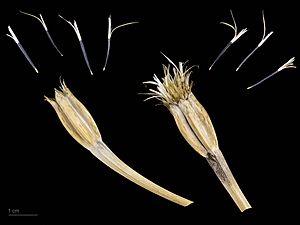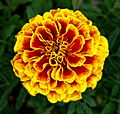French marigold facts for kids
Quick facts for kids French marigold |
|
|---|---|
 |
|
| Scientific classification | |
| Genus: |
Tagetes
|
| Species: |
patula
|
| Synonyms | |
|
|
The Tagetes patula, commonly called the French marigold, is a popular flowering plant. It is part of the Asteraceae family, which also includes daisies and sunflowers. This plant is originally from Mexico and Guatemala. You can now find it growing naturally in many other countries around the world. People love to grow French marigolds because they are easy to care for. They come in many bright shades of yellow and orange.
Some experts believe that Tagetes patula is actually the same species as Tagetes erecta, which is known as the Mexican marigold.
Contents
About the French Marigold's Name
The Latin part of the plant's name, patula, means "with a spreading habit." This describes how the plant grows outwards.
What French Marigolds Look Like
The French marigold is an annual plant. This means it completes its entire life cycle in one growing season. It can grow up to 0.5 m (1.6 ft) tall and 0.3 m (1.0 ft) wide. In many places, it blooms from July to October. In its natural home in central Mexico, it flowers from September until the first hard frost.
The flowers have both male and female parts. They are mostly pollinated by beetles in the wild. Other insects, like tachinid flies, also help pollinate them. All marigold plants have special glands in their leaves that produce oils. These oils have a strong smell.
French marigolds can grow well in both sandy and clay soils. The soil just needs to drain water easily. They need full sun to partial shade to grow best. They can handle cold temperatures down to -1 °C. However, they are sensitive to frost and do not grow well in shady spots.
Growing French Marigolds
Gardeners really like French marigolds for their beautiful, brightly colored flowers. These flowers have a soft, velvet-like texture. They bloom in shades of yellow, orange, and brown during the summer. French marigolds are usually shorter than their relative, the Mexican marigold (Tagetes erecta). They also tend to spread out more. This makes them perfect for planting along the edges of garden beds.
French marigolds are often used in a technique called companion planting. This means planting them near other crops. Their roots release substances that are thought to kill tiny worms called nematodes in the soil. They are also said to keep away harmful insects, like whiteflies, from plants such as tomatoes. However, some studies have shown that they can sometimes attract certain pests, like the Colorado potato beetle, instead of repelling them.
Popular French Marigold Varieties
Many different types, or cultivars, of French marigolds have been created. Here are some popular ones that have won awards for their excellent qualities:
- 'Bonanza Flame'
- Bonanza Series
- 'Dainty Marietta'
- 'Disco Orange'
- 'Disco Yellow'
- 'Fireball'
- 'Hero Orange'
- 'Honeycomb'
- 'Queen Sophia'
- 'Safari Mixture'
- 'Safari Scarlet'
- 'Safari Tangerine'
- 'Tiger Eyes'
- 'Yellow Jacket'
- 'Zenith Golden Yellow'
- 'Zenith Lemon Yellow'
- 'Zenith Yellow'
Other Uses for French Marigolds
French marigolds are useful for more than just looking pretty!
Medicinal Uses
In many cultures, people use dried leaves or flowers from marigolds to make special teas or infusions. Research also suggests that the essential oil from Tagetes patula might be used as a natural pesticide against bedbugs. Scientists are also studying its essential oil to see if it can fight fungal infections, including those in humans like candidiasis and those that affect plants.
Culinary Uses
The dried and ground petals of French marigold flowers are a popular spice in the country of Georgia. There, they are called imeruli shaphrani, which means 'Imeretian Saffron'. They get this name because of their strong flavor and golden color. This spice is especially popular in the Western province of Imereti. It adds a unique, earthy taste to Georgian cuisine. It goes very well with the flavors of cinnamon and cloves. It is also a key ingredient in a spice mix called khmeli suneli, which is very important in Georgian cooking.
Coloring Uses
French marigold flowers are grown and harvested every year to add to chicken feed. This helps to give egg yolks a nice golden color. The flowers can also be used to color human foods. A golden yellow dye made from the flowers can color animal-based fabrics like wool and silk without needing extra chemicals. However, for cotton and synthetic fabrics, a special chemical called a mordant is needed.
Fragrance Uses
When the plant is in flower, the whole plant is harvested. Then, an essential oil is extracted from it. This oil is used to make perfumes. It is often mixed with sandalwood oil to create a perfume called 'attar genda'. About 35 kg (77 lb) of this oil can be made from one 1 hectare (2.5 acres) of plants. This amount of land can produce about 2,500 kg (5,500 lb) of flowers and 25,000 kg (55,000 lb) of plant material.
Gallery
See also
 In Spanish: Clavel de moro para niños
In Spanish: Clavel de moro para niños












